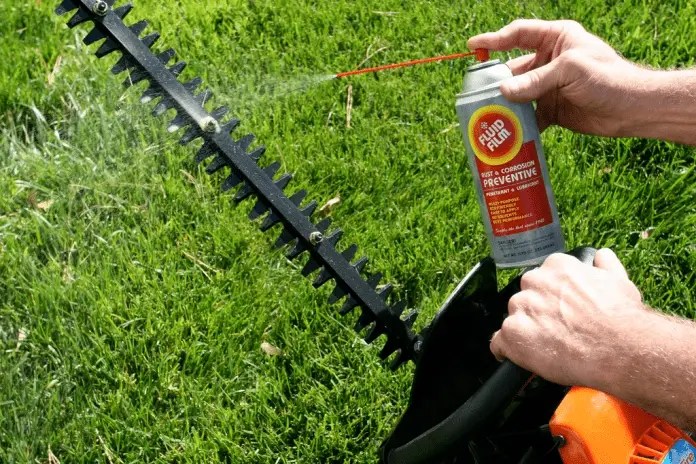Over time, you may see that your hedge trimmer’s blades start to stick when you try cutting the different shrubbery and hedges in your garden or yard. Not only will this make it challenging to get any gardening done, but it can also give you jagged and unclean cuts. To ensure your trimmer blades are in perfect condition no matter how much you use them, you should lubricate them regularly.
A hedge trimmer is one of the tools that simplify trimming shrubs and hedges into a uniform shape, and like with any tool, it can get sticky after repeated use. A hedge trimmer oil comes in because these tools often need lubrication to keep them running like new. Maintaining your hedge trimmer is a lot, but doing it right will make a real difference, and the results will show over the hedges.
You need to create a functioning schedule you can follow, and the routine becomes hard to crack. You can also clean once a week to ensure that nothing sticks inside the hedge trimmer and, as a result, clog up the system. Keep on reading to know all you need to know about hedge trimmer oil and if it’s necessary.
How Should I Know the Best Hedge Trimmer Oil?
Choosing the best hedge trimmer oil is not as hard as it seems, and heavy-duty commercial oil works fine over your trimmer. However, home oils aren’t suitable for this purpose, so you should try and find an oil that isn’t too toxic, is plant safe and is environmentally friendly. If you ignore these points, it can cause damage to your plants when you trim through them.
If you still have the instructions that came with your hedge trimmer, you can check them before you purchase oil for your hedge trimmer. The manufacturer will most likely recommend an oil that will work well on its product, for instance, WD-40. Generally, any tool oil or grade engine oil can lubricate the blades.
However, the hedge trimmer lubricant is not as important as how often you oil your trimmer and how thoroughly you will lubricate it. Nonetheless, the oil you choose makes a huge difference, but you should try to stick to fresh oils and store them in a dark and dry location.
2 Cycle Engine Lube
With a gas-powered hedge trimmer, one mixes the gas with 2-stroke oil. The ratio varies from one model to another. Some models, such as Stihl, will have specific type 2 stroke oil.
Most trimmers run between 40:1 and 50:1, which means 50 parts of gas to 1 part of the oil. Keep in mind that mixing small gas amounts and oil will not be accurate. Always shake your can before you refuel, as the oil and gas will separate when stored. You shouldn’t leave the gas in the hedge trimmer after use. If it goes off, it will cause many problems.
The regular gas 87 or 89 octanes is the best choice, but ethanol e10 also works fine. However, E15 and e85 are not acceptable as they may cause engine damage and void your warranty.
Check Transmission Lube
All hedge trimmers come with a transmission gas-powered, electric and battery. It will be located where the blades meet the body. All the transmissions are lubricated, and some will need lubrication to be added from time to time. However, most battery and electric models are considered oiled for life. This means you will not need to check, change or top it up.
The gas-powered models will need to be topped and checked up. Some hedge trimmers can use a grease gun to pack the transmission through a maintenance grease bung or nipple. However, other manufacturers will make you remove the transmission cover plate, so you should top up and check every 25 hours after use or every three seasons.
Notably, grease type usually varies from one manufacturer to another, but the white lithium grease is normally used. You won’t need to remove the blades to grease the tranny but removing them will make sharpening your blades so much easier. The blades are timed, and your top blade may differ from the lower blade, so it’s important to mark them before disassembling them.
Is Hedge Trimmer Oil Necessary?
Yes, hedge trimmers usually need lubrication to minimize the friction between the blades and prevent any excess heat that can bend your trimmer’s blades. However, unlike chainsaws, hedge trimmers don’t have an oil reservoir, so oil is applied directly to the trimmer blades.
Hedge trimmers are maintained in the best working condition by oiling the trimmers after every use. You can apply your hedge trimmer lubricant before pruning a bush or a hedge to help prevent sap from the hedges from sticking to the blades. After using the trimmer to prune a hedge, Oiling helps remove sap from blades while keeping the blades moist during storage.
Notably, using a hedge trimmer lubricant on your blades is not necessary to minimize rusting because they are pre-hardened and rust-resistant steel.
When To Oil Your Hedge Trimmer?
Oiling is something you never get enough of unless the oil starts coming out of the trimmer; then, you can assume a little too far. You should oil your trimmer against a rough, long hedge-trimming day. You should oil your hedge trimmer nicely and thoroughly, so your job doesn’t delay against rusted metal and stiff joints.
When you oil your blade, you also help prevent any leaves, sap, and debris from sticking to your trimmer while working. Therefore, it’s important to oil your hedge trimmer as often as possible and even though you don’t have to, do it every time.
How To Oil Your Hedge Trimmer?
There are various ways you could oil your hedge trimmer, but you should always remember that you will need to be as gentle as possible. Creating scratches or nicks on your blade or metal will make it liable to developing rust. However, not oiling your hedge trimmer thoroughly could mean you have left out the important points on your blade that will keep stiffening and rusting.
Electric, battery-powered, gas and pole hedge trimmers fit inside the same category for oiling. You can apply your hedge trimmer lubricant directly to your blades, and whether it’s a drop or spray style, the applicator won’t matter.
In addition, you can oil your hedge trimmer in different ways, although not all ways are good for all trimmers.
- One can safely dip their blade into a pan with the hedge trimmer lubricant if they have a manual trimmer.
- For an electric trimmer, rub the oil onto the blade with a cloth or spray the oil onto the blades. Have the trimmer unplugged and in an off position before you start it. If you are using a battery-powered hedge trimmer, ensure the battery isn’t in the machine. This is to avoid the oil leaking into the battery and ruining it.
- Gas hedge trimmers should not have gas in the tank. When the machine is on, the oil and sparks could be a dangerous combination to encounter.
- Also, one can fill a sock with sand and apply the hedge trimmer oil using the sock. Alternatively, use a cloth where you will start by taking the blade off your trimmer or leaving it inside. However, be cautious of the joints on the hedge trimmer. Getting too much oil inside the system could loosen something in your hedge trimmer.
- Ensure the cloth is dry before using it; otherwise, it won’t work properly. Slowly move the slippery part of the cloth over your blade. Then, fit your fingers into the corners and nooks, likely to stiffen and rust.
- If you find rust along your blade, rub gently over the rust spots with the cloth. If it doesn’t come off, use a cleaner or soap to remove them. When it comes to the blade’s teeth, weave each thoroughly, and this part will not rust. This will keep the trimmer working.
- The blade doesn’t have to drip the oil by the end of the process. You should ensure everything has a generous coating.
How to Store Your Hedge Trimmer?
When it comes to a hedge trimmer, whether battery, electric or gas-powered, the blade care is the same. Clean the blades after use using a cloth and a stiff brush to remove any foliage. Allow the blades to fully dry out before coating them with WD40 or an oily rag.
Fit your scabbard well as the blades can still move when pushed. This can be dangerous to little pets and fingers. Notably, gas-powered trimmers should drain the gas when it’s not in use. Alternatively, use a gas stabilizer that will keep the gas fresh.
If you winterize your trimmer, fill your gas tank up using the treated gas, preventing moisture in the tank. Always clean the air filter and spray the entire machine with a WD40 coat. This is to protect your hedge trimmer from dampness and corrosion. In addition, avoid covering your machine with plastic as this might promote condensation. Thus, it’s better to store it somewhere dry.
Image Credit: lawnsite.com




